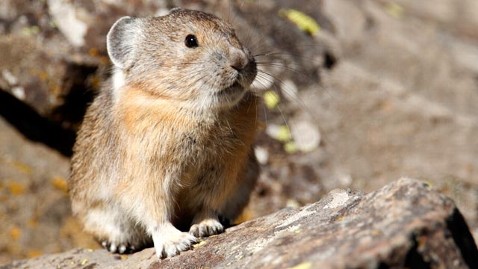Cute Animal + Warming Climate = New Species (of News)

(Getty Images)
NATURE’S EDGE NOTEBOOK
Observation, Analysis, Reflection, New Questions
By Bill Blakemore
The unprecedented and immense problems now brought on by manmade global warming are transformative in many ways.
The world’s national intelligence and security agencies, finance leaders, insurance companies, and food markets are all rearranging plans as they adjust to accelerating climate disruptions.
Less noticed, but no less telling of its effect on our feelings, is how the climate crisis has transformed the durability of some of our news segments.
It has produced a new species of reports that paradoxically grow ever more urgent, more “newsworthy,” after we first publish them – as if they were swimming in some sort of journalistic Fountain of Youth.
‘Third Cutest Animal in North America’
For example, consider this brief (130 seconds) video spot about The American Pika, a small animal beloved of Rocky Mountain hikers – and claimed by some enthusiastic biologists to have been voted (in a surely unscientific poll) “the 3 rd cutest animal in North America:
That report first aired on ABC’s “World News Tonight” in 2007. Since then, the plight of the American pika has only worsened.
We occasionally rerun such reports, which first aired even four or five years ago, on our overnight digital feeds without changing a word and find they are still as fresh as ever.
We did change one word in that pika report to update its science — after a phone call to check with ecologist Erik Beever, Ph.D., co-editor of the new book, “Ecological Consequences of Climate Change.”
He told us that “pika extirpations (local extinctions) are increasing” and directed us to new studies showing pikas now gone from another two nesting sites.
This reporter then recorded the word “ten,” and Nature’s Edge video editor Mark Monroy laid it into the 2007 version (created by ABC video editor Tom Gubar) where I had said “eight.”
Everything else in this spot, including their usual enemies, the hungry leaping mountain weasels, is just as up-to-date as it was when we first did the spot.
Why do some of our past reports — especially those related to global warming — continue to feel as fresh as tomorrow?
For at least three reasons.
The Psychology of a Story ‘Too Big to Cover’
First, most of those reports cover natural earth systems that flow in longer wavelengths. The changes they tell of — say, vanishing species or glaciers — are slower than changes in many “hard news” stories. So they stay current for a longer time.
The news of these climate change impacts is no less urgent, but their “breaking news” breaks over a longer period — a matter of years — than that of many political scandals, which are old news within a month.
Second, the news about manmade global warming is so big, all-involving, has so many moving parts, it’s hard for anyone to hold it all in mind all at once.
Global warming is almost the story that’s too big to cover … and too big to absorb.
It takes a long time for anyone who is not a climate scientist to really accept it and mentally assemble all the hard new realities we are learning about.
For journalists, this means that each month, in effect, new waves of people show up saying, “OK, I guess it’s real. Now what was that again — what you reported five years ago?”
These first two factors keep these reports new. The third makes them ever newer:
It’s that the reports from the climate scientists grow steadily worse.
For example, the Department of Energy has just announced that global greenhouse emissions for the year 2010 turn out to have exceeded even the “worst case scenario” of the most recent major U.N. projections.
Reactions to this from established scientists, reported by The Associated Press, include phrases like “really dismaying” and “a monster increase … unheard of.”
The cumulative effect of this worsening news naturally keeps heightening our awareness, so our second looks are more sharply focused; you see old news with new eyes.
As you become more convinced manmade global warming is real, old reports may seem like the first time to be “real news” — especially if the problem reported is still growing even worse.
‘A Natural Denial, Even This Reporter…’
Even though this reporter has been working the climate story since 2004, hardly a day goes by that I don’t find myself once again being pulled back out of natural denial about it after talking with — or reading yet another report by — climate science professionals long inured to living with the hard evidence.
And of course, the longer you ponder the evidence, the greater the number of personal concerns you may bring to such concise and natural metaphors as The American Pika.
Yes, American pika is its formal scientific name.
In the rising heat, it may be easier for Americans to think about the plight of the distant, lofty little pika than that of our own children — just as viewers are thought to be more inclined to wear seat belts after seeing slow-motion video of crash-test dummies than pictures of mangled corpses.
And the world’s climate scientists — working with economists, flood control engineers, military security specialists, agronomists and many other professionals — are telling us that, like it or not, we are all now facing a problem … bigger than weasels.